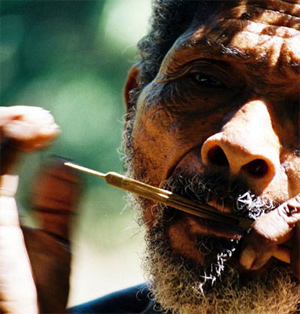High death rates drove evolution of human pygmies
New theory on the evolution of pygmies
mongabay.com
December 10, 2007
Early childbearing age in the face of high death rates, drove evolution of small stature of human pygmy populations
The small body size of forest-dwelling “pygmies” evolved as a life history consequence of early death, not as an adaptation to their environment or endurance against starvation, argues a new study published in the journal Proceedings of the National Academy of Sciences (PNAS).
Constructing growth curves for the Aeta, a group of compact forest-dwelling people in the mountainous parts of the Philippine island of Luzon; and comparing with those for the Biaka (central African pygmies) and Agta (Filipino pygmies), Andrea Bamberg Migliano of Cambridge University and colleagues speculate that human pygmy populations evolved as a by-product of selection for early onset of reproduction.
“Human pygmy populations and adaptations evolved independently as the result of a life history tradeoff between the fertility benefits of larger body size against the costs of late growth cessation, under circumstances of significant young and adult mortality,” the authors write. “Human pygmies do not appear to have evolved through positive selection for small stature—this was a by-product of selection for early onset of reproduction.”
 Aeta shaman plays the Kulibaw in a ritual to exorcise the “spirit of death.” The Aeta and other pygmies have the highest mortality rates among all human populations; their small body size evolved as a life history consequence of early death. Photograph courtesy of Rodolph Schlaepfer. |
The research challenges traditional explanations of human pygmy body size, including adaptation “to living in dense tropical forests, thermoregulation, or endurance against starvation in low productivity environments.”
“None of these explanations account for the worldwide distribution of human pygmies—some pygmy-sized populations are found outside forests, and many live in cool and dry areas; furthermore, long-standing poor nutrition does not necessarily lead to pygmy size, as shown by groups who, like certain pygmies, experience frequent food shortages and yet are among the tallest populations in the world,” Migliano and colleagues write. “The adaptive value of pygmy body size remains an unanswered question in human evolutionary biology, and one thrown into sharp relief by the recent discovery of a small-bodied fossil hominin population of Flores.”
Human pygmies are generally defined as populations having an average male height 155 cm. While the word “pygmy” is frequently used to describe historically nomadic groups living in African rainforests, pymies are widely distributed, including populations in the Andaman Islands, Malaysia, Thailand, Indonesia, the Philippines, Papua New Guinea, Brazil, and Bolivia.
CITATION:
Andrea Bamberg Migliano, Lucio Vinicius, and Marta Mirazón Lahr. Life history trade-offs explain the evolution of human pygmies. PNAS week of December 10, 2007














